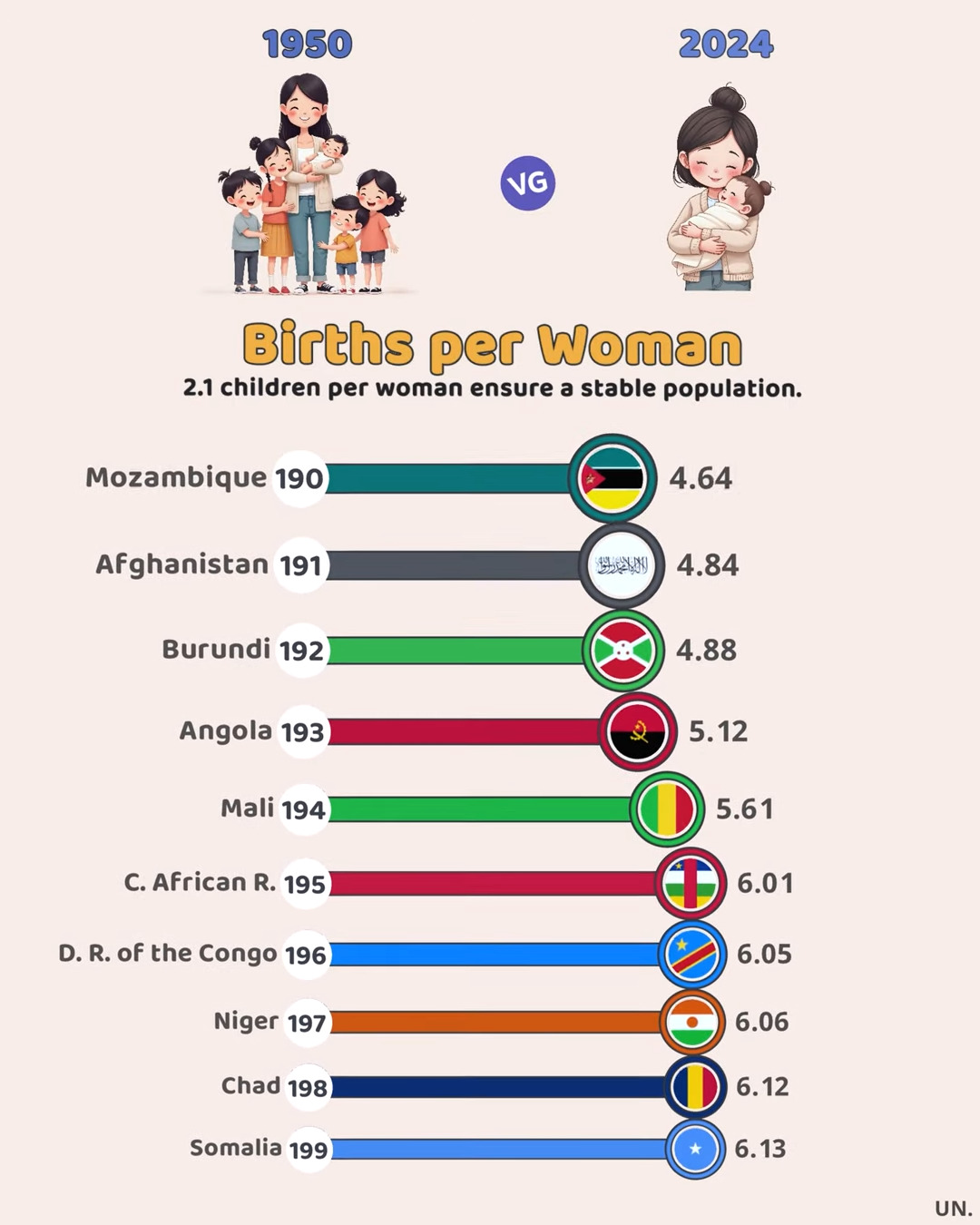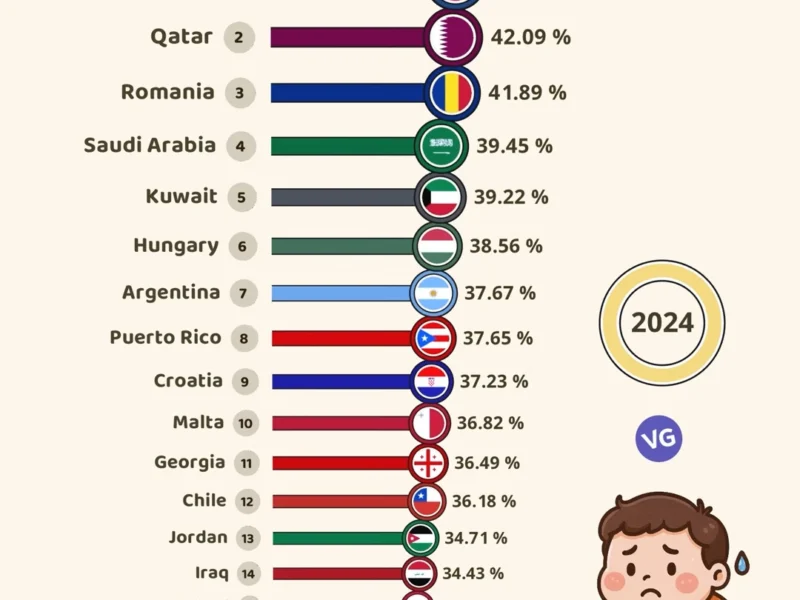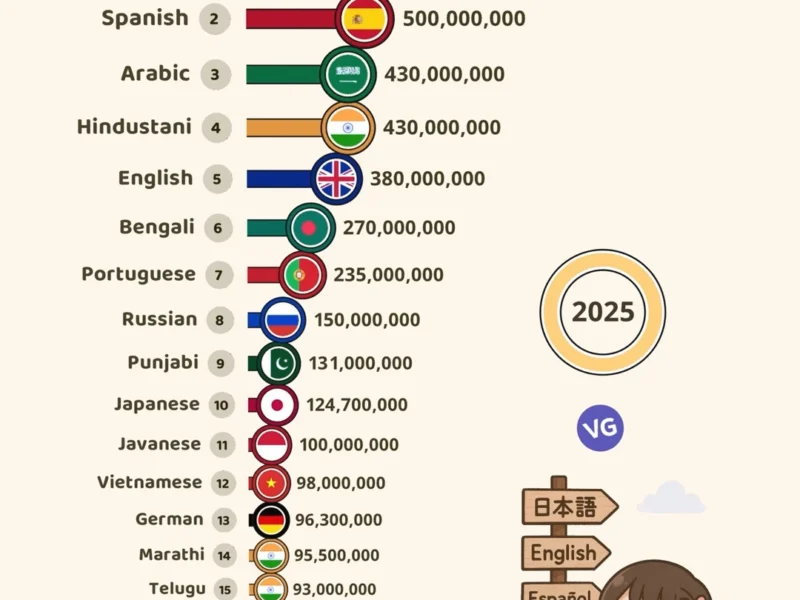Niger leads with 6.06 births per woman in 2024, far above the global average of 2.3. This shows how different countries have varying fertility rates. It’s key to understand these trends to manage population growth and demographic changes.
The global fertility rate has dropped, with 2.3 children per woman in 2022, the World Bank reports. This fall is due to better education and family planning, and shifts in culture and economy. Countries like Niger, Chad, and the Democratic Republic of Congo have much higher rates, from 6.0 to 6.6 births per woman.
Top Country Births per Woman in 2024
| Country | Births per Woman (2024) | Flag |
|---|---|---|
| Mozambique | 4.64 | 🇲🇿 |
| Afghanistan | 4.84 | 🇦🇫 |
| Burundi | 4.88 | 🇧🇮 |
| Angola | 5.12 | 🇦🇴 |
| Mali | 5.61 | 🇲🇱 |
| Central African Republic | 6.01 | 🇨🇫 |
| Democratic Republic of the Congo | 6.05 | 🇨🇩 |
| Niger | 6.06 | 🇳🇪 |
| Chad | 6.12 | 🇹🇩 |
| Somalia | 6.13 | 🇸🇴 |
Looking into why some countries have high birth rates is crucial. It helps us understand global population growth and demographic shifts. By studying these trends, we can create better strategies to handle these issues. This knowledge guides policies and initiatives aimed at managing population and fertility rates.
Understanding Global Fertility Rates in 2024
The number of children per woman worldwide has been going down. In 1950, it was about five, but by 2021, it dropped to 2.2. Experts think it will keep falling, reaching 1.8 by 2050 and 1.6 by 2100. Today, the average is 2.3 children per woman, with big differences in different places.
The total fertility rate (TFR) is a key factor in this change. It’s the average number of kids a woman might have in her life. It’s based on how many babies are born each year. Birth rates have also been falling in many countries.
Defining Total Fertility Rate (TFR)
The total fertility rate (TFR) is a key number for understanding fertility worldwide. It’s found by adding up the birth rates for women of all ages. The TFR helps us see how fast a population might grow and predict future trends.
Current Global Average Birth Rates
Right now, the global average is 2.3 children per woman. But, there are big differences around the world. Chad has a high TFR of 7, while South Korea’s is less than 1.1.
Methods of Data Collection and Analysis
There are many ways to gather data on fertility rates. Surveys, censuses, and records are used. By analyzing these, we can understand how fertility and population growth are changing.
The table below shows what the total fertility rates might be in different parts of the world:
| Region | 2021 | 2050 | 2100 |
|---|---|---|---|
| Africa | 4.3 | 3.2 | 2.5 |
| Asia | 2.2 | 1.8 | 1.6 |
| Europe | 1.5 | 1.4 | 1.3 |
| Latin America | 2.1 | 1.8 | 1.6 |
| North America | 1.7 | 1.6 | 1.5 |
Knowing about fertility rates and birth rates is key to understanding population growth. This knowledge helps shape policies and programs to tackle these challenges.
Top Country Births per Woman in 2024: Regional Leaders
The top country births per woman in 2024 are mainly in Africa. Countries like Niger, Angola, and the Democratic Republic of Congo are at the top. They have fertility rates from 5.76 to 6.73 children per woman, much higher than the global average.
According to the World Bank, the top countries with the highest fertility rates are:
| Country | Fertility Rate (children per woman) |
|---|---|
| Niger | 6.73 |
| Angola | 5.76 |
| Democratic Republic of Congo | 5.56 |
| Mali | 5.45 |
| Benin | 5.39 |
These regional leaders in fertility rates are leading the population growth in their areas. This has big effects on their economies, healthcare, and education. It’s key to understand these trends to tackle population growth and demographic changes.
Factors Influencing High Birth Rates
High birth rates come from many factors. These include cultural and religious beliefs, economic status, and access to healthcare and family planning. The UN says these factors are key in developing regions. The total fertility rate shows how many kids a woman might have in her life.
Culture and religion greatly affect birth rates. Some groups see big families as important. Socioeconomic conditions like poverty and lack of education also play a part. Not having good healthcare and family planning options can make birth rates higher and riskier.
- Cultural and religious influences
- Socioeconomic conditions, such as poverty and limited access to education
- Access to healthcare and family planning resources
- Government policies and support systems, such as family planning programs and economic incentives
It’s important to understand these factors to tackle high birth rates. By looking at how these factors work together, we can make better plans. This helps families and communities, leading to a healthier and more sustainable future.
Conclusion: Future Trends and Global Population Impact
The world’s population is changing, and so are fertility rates. The latest numbers show the population will hit 10.3 billion in the mid-2080s. It will then drop to about 10.2 billion by the end of the century. This future trend will affect how we use resources, develop sustainably, and protect the environment.
The global population impact of these changes is complex. But knowing what affects fertility rates is key. Policymakers and healthcare experts need to work together. They must ensure everyone has access to family planning, healthcare, and education.
By being proactive and collaborative, we can aim for a better future. A future that is sustainable and prosperous for everyone.
FAQ
What is the current global fertility rate?
The global fertility rate has been falling. In 2022, it was 2.3 children per woman, says the World Bank. This drop is due to better education and family planning, and changes in culture and society.
How is the total fertility rate (TFR) defined?
The total fertility rate (TFR) shows the average number of children a woman would have in her life. It uses the current fertility rates for each age group. This gives a clearer view of fertility trends.
What are the methods of data collection and analysis for fertility rates?
To understand fertility rates, we use surveys, censuses, and administrative records. These tools give us important insights into fertility and population growth.
Which are the top countries with the highest fertility rates in 2024?
The countries with the highest fertility rates are mostly in Africa. Niger, Angola, and the Democratic Republic of Congo lead with rates from 5.76 to 6.73 children per woman. These rates are much higher than the global average.
What are the key factors influencing high birth rates?
Many factors affect high birth rates. Cultural and religious beliefs, economic conditions, healthcare access, and government policies all play a part. Cultural and religious views often value large families. Poverty and lack of education also contribute to high birth rates. Limited healthcare and family planning resources make things worse. But, government support can help manage these issues and promote sustainable growth.
Source Links
- List of countries by total fertility rate
- Birth Rate by Country 2024
- The Lancet: Dramatic declines in global fertility rates set to transform global population patterns by 2100
- Highlights From the 2024 World Population Data Sheet
- Fertility Rate
- Total Fertility Rate 2024
- Five Facts and Trends From 2024 That You Should Know
- The Demographic Outlook: 2024 to 2054
- Declining birth rate in Developed Countries: A radical policy re-think is required
- Birth rate
- Peak global population and other key findings from the 2024 UN World Population Prospects
- Population | United Nations
- World Population Prospects 2024: Summary of Results – World



